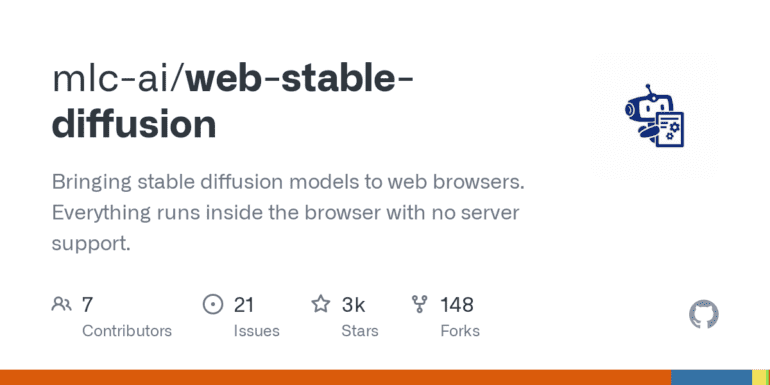TL;DR:
- Stable diffusion brings photorealistic image generation from text input.
- Web Stable Diffusion allows running AI models directly in web browsers.
- Computation is shifted to client-side, reducing costs and enhancing security.
- The project utilizes open-source technologies like PyTorch, Hugging Face, rust, and wasm.
- TVM Unity and Apache TVM form the foundation of the workflow.
- Machine learning compilation technology plays a central role in the project.
- The team optimizes code generation and memory reuse for efficient performance.
- The vibrant open-source community enables collaborative development.
- Web Stable Diffusion revolutionizes AI experiences on the web.
Main AI News:
In recent years, the advancements in artificial intelligence (AI) models have been nothing short of remarkable. Thanks to the open-source movement, programmers have been able to combine various open-source models, unleashing a wave of novel applications.
One groundbreaking development in this realm is stable diffusion, a technique that enables the automatic generation of photorealistic images and other artistic styles from simple text input. However, due to their size and computational intensity, these models often rely on GPU servers when integrated into web applications. Moreover, deep-learning frameworks typically require specific GPU families to function effectively, adding further complexity to the equation.
Enter the Machine Learning Compilation (MLC) team with their innovative project aimed at transforming the current landscape and promoting biodiversity in the environment. They envisioned a paradigm shift where computation is shifted to the client-side, offering benefits such as reduced service provider costs and highly personalized experiences with enhanced security.
According to the team, the ML models should be capable of running on a client’s machine without the need for GPU-accelerated Python frameworks. Since AI frameworks heavily depend on optimized computed libraries provided by hardware vendors, having a backup plan is crucial. To maximize efficiency, they propose generating unique variants tailored to each client’s infrastructure.
The proposed solution, Web Stable Diffusion, introduces the diffusion model directly into the web browser, leveraging the client’s GPU for computations on their laptop. All operations are processed locally within the browser, eliminating the need for server interaction. The team proudly claims that this marks the advent of the world’s first browser-based stable diffusion.
At the heart of this revolutionary approach lies the machine learning compilation technology (MLC). The solution builds upon a collection of open-source technologies, including PyTorch, Hugging Face diffusers and tokenizers, rust, wasm, and WebGPU. The main workflow is constructed on Apache TVM Unity, an exciting work-in-progress within the Apache TVM project.
The team has utilized the Hugging Face diffuser library’s Runway stable diffusion v1-5 models, effectively capturing key model components in an IRModule using TorchDynamo and Torch FX. With the IRModule, executable code can be generated for each function, enabling deployment in various environments that support at least the TVM minimum runtime, including JavaScript.
To automate code generation and ensure optimal performance, TensorIR and MetaSchedule are employed to create scripts that generate efficient GPU shaders using the device’s native GPU runtimes. The team has also established a repository for these adjustments, facilitating future builds without the need for extensive fine-tuning.
Furthermore, the team has implemented static memory planning optimizations to enhance memory reuse across multiple layers. The TVM web runtime leverages Emscripten and TypeScript to facilitate module deployment.
In addition, they utilize the wasm port of the Hugging Face rust tokenizers library, seamlessly integrating it into the workflow. The entire development workflow, except for the final step of creating a JavaScript app to unify all components, is performed in Python. This participatory development approach opens doors to introducing new models and fosters an exciting atmosphere of collaboration.
None of this would be possible without the vibrant open-source community. The team heavily relies on TVM Unity, the latest and most intriguing addition to the TVM project. This Python-first interactive MLC development experience empowers them to create additional optimizations in Python and progressively release the app on the web. TVM Unity also serves as a catalyst for rapidly composing novel ecosystem solutions.
Conclusion:
The introduction of Web Stable Diffusion signifies a significant breakthrough in AI integration with web browsers. By enabling the generation of photorealistic images and other artistic styles from text input, this project opens up new possibilities for web-based AI applications. Shifting computation to the client-side offers cost savings and improved security, while the utilization of open-source technologies ensures scalability and flexibility. With the support of machine learning compilation technology and a vibrant open-source community, Web Stable Diffusion paves the way for personalized and interactive AI experiences on the web. This development holds immense potential for the market, providing businesses with opportunities to enhance user experiences, reduce costs, and explore innovative AI-driven applications in web environments.

